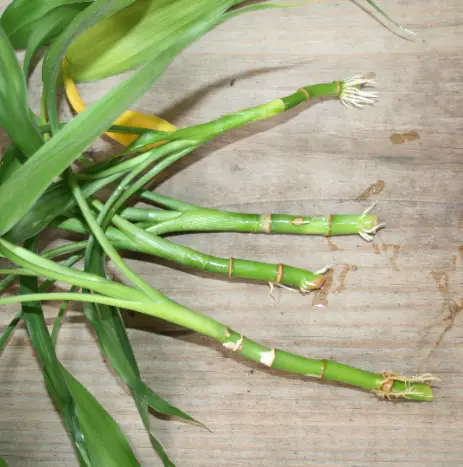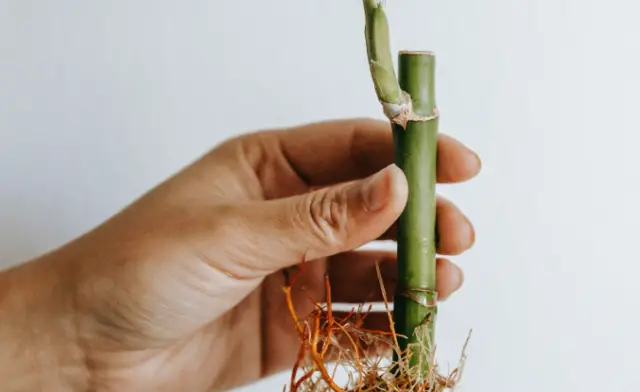Bamboo plants, especially the popular lucky bamboo (Dracaena sanderiana), are cherished for their elegance and symbolism. However, when those vibrant green leaves start to fade to yellow, it’s time to investigate. Let’s explore the possible reasons behind this color change and how to revive your bamboo:

Lucky Bamboo Plant
1. Too Much Sunlight
While sunlight is essential for plant growth, direct exposure to intense sunlight can harm your lucky bamboo. Yellowing leaves or even crispy dryness may occur. Solution: Relocate your plant to a spot with dappled or indirect sunlight. Trim off damaged leaves to encourage new growth.
2. Overwatering
Overwatering is a common culprit. If you grow your bamboo in water with pebbles, the leaves may turn yellow due to stagnant water. Ensure you change the water frequently (at least once a week) to prevent this issue.
3. Over-Fertilizing
Too much fertilizer can lead to leaf discoloration. Lucky bamboo doesn’t require excessive nutrients. A drop of liquid fertilizer once a month is sufficient. High-quality potting mix with good drainage should provide necessary nutrients.
4. Harsh Water
Chemicals in tap water (used for softening or purification) can negatively affect your bamboo. Consider using distilled water or collect fresh rainwater for watering. If using tap water, let it sit for an hour to allow chlorine and other chemicals to dissipate.
5. Abrupt Temperature Changes
Winter drafts near windows or doors can stress your bamboo, causing yellowing leaves. Similarly, sudden indoor heating can have the same effect. Solution: Move your plant away from temperature fluctuations.
6. Overcrowded Container
Healthy bamboo roots need space. If your plant has outgrown its container, repot it. For water-grown bamboo, clean the pebbles before transferring to a new container. Soak them in vinegar or soapy water to remove potential bacteria.
7. Low Soil Nutrients (Outdoor Bamboo)
Outdoor bamboo may turn yellow due to insufficient soil nutrients. Ensure proper fertilization and consider adding organic matter to the soil.
Remember, a yellow stem often indicates a more significant issue than a yellow leaf. Observe your bamboo closely, make necessary adjustments, and watch it thrive once again! 🌱
What is The Best Way to Care For Lucky Bamboo?
Lucky bamboo (Dracaena sanderiana) is a delightful and low-maintenance houseplant that brings positive energy and prosperity to your home or office. Here are some essential care tips to keep your lucky bamboo thriving:
- Light and Location:
- Place your lucky bamboo in bright, indirect sunlight. Avoid direct sun exposure, as it can scorch the leaves.
- Keep it away from drafty areas or sudden temperature fluctuations.
- Watering:
- If growing in soil, ensure the pot has a drainage hole. Use a mix of sand, peat moss, and regular soil for excellent drainage.
- Water the plant just enough to keep the soil moist, but avoid overwatering.
- For water-grown bamboo, maintain at least an inch of standing water in the container. Change the water weekly to prevent root rot.
- If using tap water, let it sit out for 24 hours to reduce chemicals before watering your bamboo.
- Fertilization:
- Lucky bamboo doesn’t need excessive nutrients. Use a small amount of liquid fertilizer once a month.
- High-quality potting mix with good drainage should provide necessary nutrients.
- Container Choice:
- Choose a pot that is 2 inches larger in diameter than the plant.
- Clear containers work well for water-grown bamboo, showcasing the pebbles and roots.
- Stabilize the Stalks:
- Tie multiple stalks together with ribbon wire or ribbon to keep them stable, especially if growing in water.
- Temperature:
- Lucky bamboo prefers a temperature range of 65–95°F (18–35°C).
- Avoid extreme cold or hot conditions.
Lucky bamboo like any green companion, can encounter issues. Let’s explore some common problems and how to address them:
- Yellowing Leaves:
- Cause: Yellow leaves may result from too much sunlight or insufficient watering.
- Solution: Place your lucky bamboo in bright, indirect sunlight and adjust watering to keep the soil consistently moist.
- Root Rot:
- Cause: Overwatering can lead to root rot. Lucky bamboo is often grown in water, so stagnant water can be problematic.
- Solution: Change the water regularly (at least once a week) to prevent root rot.
- Chlorine Toxicity:
- Cause: Tap water with chlorine can harm lucky bamboo.
- Solution: Use distilled water or let tap water sit for 24 hours before watering.
- Fertilizer Burn:
- Cause: Excessive fertilizer can cause leaf discoloration.
- Solution: Use a small amount of liquid fertilizer once a month.
- Cold Damage (Chilling Injury):
- Cause: Lucky bamboo prefers warmth. Exposure to cold temperatures can lead to chilling injury.
- Symptoms: Yellow margins on leaves or wilting.
- Solution: Trim affected areas and move the plant away from cold sources.
- Pests:
- While pests are less common, you might encounter fungus gnats or mealybugs.
- Prevention: Regularly inspect your plant and keep it clean.
How To Revive a Dying Lucky Bamboo?
Tips for Saving Lucky Bamboo With Leaves and Stalks Turning Yellow:
- Adjust Light Exposure:
- Move your bamboo to an area with bright, indirect light. Avoid direct sunlight.
- Trim off any yellow leaves to encourage new growth.
- Watering:
- If growing in water, change the water every two weeks.
- Use rainwater if possible, as tap water chemicals can harm lucky bamboo.
- Temperature Range:
- Maintain a temperature range of 60°F to 75°F (16°C to 24°C).
- Avoid extreme cold or hot conditions.
- Pruning:
- Trim off yellow or mushy stalks.
- Consider taking cuttings from healthy parts for propagation.
How To Propagate my Lucky Bamboo?

Lucky Bamboo Plant
you can choose between two methods: water propagation and soil propagation. Let’s dive into the details:
1. Water Propagation:
- Take a Healthy Cutting:
- Use small, sterile pruners or scissors to cut an offshoot from the parent plant. Aim for a cutting that’s around 4 to 6 inches long.
- Remove the leaves from the lower half of the cutting, but ensure at least one set of leaves remains at the top.
- Rooting Hormone (Optional):
- Apply a rooting hormone to the cut end if you wish. While not essential, it can expedite the rooting process.
- Place in Water:
- Place the cutting directly in a small glass filled with distilled water.
- Keep the container in a warm spot with bright, indirect light.
- Change the water regularly to maintain freshness.
2. Soil Propagation:
- Prepare the Cutting:
- Follow the same steps to take a healthy cutting as mentioned above.
- Plant in Soil:
- Fill a small container with well-draining potting mix (cactus soil works well).
- Plant the cut end of the lucky bamboo a couple of inches down into the soil. Ensure at least one node (from which roots will grow) is under the soil line.
- Gently firm the soil around the cutting.
- Provide Ideal Conditions:
- Place the container in a warm spot with bright, indirect light.
- Water the soil to keep it lightly moist, but avoid making it soggy.
I hope this blog post helps you understand why your bamboo is turning yellow and provides practical solutions. If you have any other questions or need further assistance, feel free to ask!





